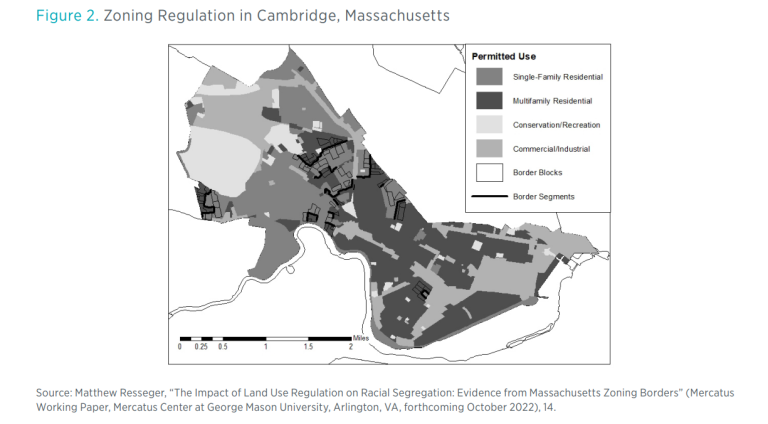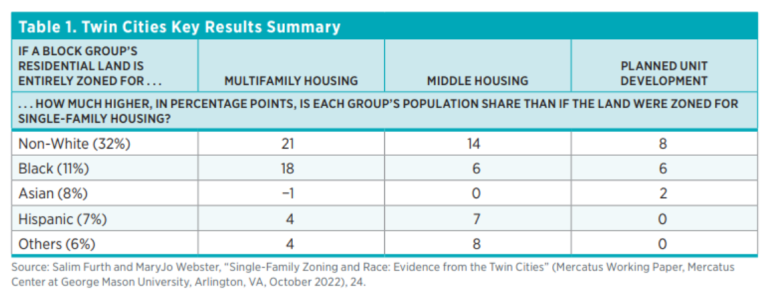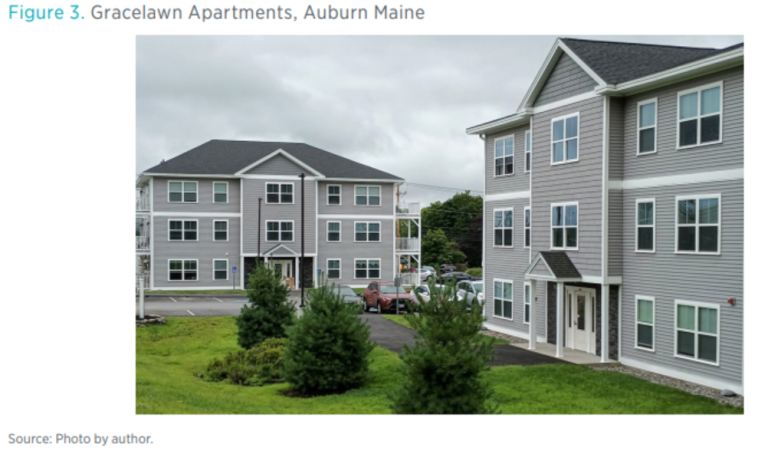- | Housing Housing
- | Policy Briefs Policy Briefs
- |
New Research Shows How Zoning Slows Racial Integration
Tamara is a striving single mother, trying to give her daughters the security and opportunities she did not have. In 2010, she was renting a house on the same decaying city block where her parents lived. But her eldest daughter was struggling in the failing neighborhood school. Bullies shoved her around and made fun of her glasses. She left the glasses at home, but then could not see the blackboard.
They needed to move. Buying a home was out of the question. Tamara might have been able to buy a house in her old neighborhood—they often sold for less than $50,000—but to what end? Those homes were slowly losing value and would have locked the family into failing neighborhood schools and nearby gang violence. Suburban home prices were far out of reach, but Tamara’s modest income was enough to cover suburban rent.
With typical diligence, Tamara found a home at a low-rise apartment complex in a distant middle-class suburb. The new home came with its own challenges, including a long commute and racial isolation. Black Americans like Tamara’s family were just 2 percent of the town’s population. It was not perfect, but it was better.
Tamara’s story echoes the research findings of two new Mercatus Working Papers, namely that multifamily rental housing is the gateway to racial integration in most American neighborhoods. Regrettably, zoning prevents apartments from being built on most residential land, thus creating a major barrier to expanding racial integration.
New Evidence
The power of zoning to separate classes and races has been obvious from zoning’s earliest days. The new papers quantify the contemporary impact of zoning restrictions in Greater Boston and Minnesota’s Twin Cities metro area. They find that zoning for multifamily housing is associated with substantially larger non-White population shares than zoning for single-family housing:
- In Greater Boston, zoning for multifamily housing increases the Black and Hispanic share of households by 9 percentage points from a single-family baseline of 18 percent.
- In the Twin Cities metro area, zoning for multifamily housing is associated with a 21 percentage point higher non-White population share, enough to double the non-White population share of an average neighborhood zoned exclusively for single-family residences.
These estimates suggest that single-family zoning remains a major barrier to extending neighborhood integration, although certainly not the only one. Unlike most other barriers to full racial integration, zoning uniquely can be addressed with straightforward, low-cost policy change.
The “chain of exclusion” that links zoning and race, shown in figure 1, is also straightforward, as journalist MaryJo Webster and I argue in our paper. Zoning determines which housing types predominate in an area. Some housing types are mostly owned; others are mostly rented. And ownership rates differ sharply by race.

Zoning reform is not a substitute for policies that equalize homeownership opportunities for all Americans. Nonetheless, as Tamara’s story shows, permissive zoning allows more families to solve their own problems using their existing resources.
Greater Boston
In his study of 270 cities and towns in Massachusetts, economist Matthew Resseger compares the zoning and demographics of blocks that share a border within a neighborhood. When blocks are separated by a stream, railroad, highway, or town line, he excludes them. Thus, the neighboring blocks share the same local amenities, transportation infrastructure, and—usually—schools. Figure 2 shows the boundaries and blocks that meet Resseger’s criteria in Cambridge, Massachusetts.
After identifying bordering blocks that have different zoning, Resseger investigates the differences in demographics between single-family and multifamily districts and between districts of each type with differing density limits.

Resseger finds a large effect of multifamily zoning on the presence of Black and Hispanic households, which he estimates separately. A block zoned for multifamily housing has on average 3.4 percentage points more Black households and 5.5 percentage points more Hispanic households.
Higher-density multifamily zones, such as those allowing at least 20 units per acre, have larger average minority household shares, although the differences between density levels are often too small to be statistically significant.
When Resseger compares single-family zoning districts allowing fewer than one house per acre to single-family districts allowing at least four houses per acre, he finds a negligible effect on the Black household share and a 1 percentage point effect on the Hispanic share.
Twin Cities
In our study of the seven-county Twin Cities metro area, Webster and I use a multivariate regression to estimate how different zoning categories are related to demographics within a Census block group.
Although the research question is the same, our study differs from Resseger’s on most technical points:
- Our paper is descriptive, not causal.
- We focus on the non-White population in the 2020 Census; Resseger uses data on Black and Hispanic heads of household in the 2010 Census, which occurred closer to the time his zoning data were collected.
- Our geographic units of analysis are block groups, which are larger than blocks and almost always have more than one zoning district.
Webster and I use zoning maps to assign each block group a share of land zoned for single-family, middle housing, Planned Unit Development (PUD), multifamily, and nonresidential uses. Zones are typically named for the densest type of housing allowed and allow most housing types that are less dense. Thus, a multifamily zone usually allows middle housing and single-family housing as well as multifamily housing. Middle housing includes townhomes, mobile homes, and two- to four-family buildings. In Minnesota, PUD zoning is widely used in contemporary suburban development, and it often enables a mix of housing types.
Table 1 reproduces a table from our paper that summarizes the key results. We estimate the relationships between each of the four residential zoning categories and non-White population shares (together and by race and ethnic subgroup). Our regressions control for geographic factors, such as the distance to downtown. However, there are many other factors we do not include, some of which likely influenced the mapping of zoning districts. That approach is why our results are descriptive rather than causal.

We find that, relative to single-family zoning, multifamily zoning is associated with a 21 percentage point higher non-White population share. In a metro area in which only 32 percent of people are non-White, this is a large figure indeed. Zoning that allows middle housing is associated with a 14 percentage point higher non-White population than is single-family zoning, even though the majority of homes in middle housing districts are detached single-family houses.
From our subgroup estimates, multifamily housing appears to be especially influential in including Black residents, whereas middle housing is associated with larger Hispanic and multiracial shares.
Escaping the Past
A weakness of both papers is that they are snapshots taken at the end of a long co-evolution of zoning, structures, and race. Zoning mainly influences housing when it is built, and most existing neighborhoods, even if rezoned, would not be quickly rebuilt. Even Resseger’s causal estimates are of limited value to a policymaker asking how a new rezoning would impact demographics.
The persistence of neighborhood racial composition is also a threat to the validity of the results. If 20th-century racial composition heavily influenced both zoning and 21st-century racial composition, researchers might find a spurious correlation between zoning and 21st-century racial composition.
However, both papers also show evidence that neighborhoods do escape the past and that current policy matters. In Greater Boston, Resseger compares opposite sides of neighborhood streets, which usually share the same demographic history. In the Twin Cities metro area, Webster and I are able to include data on racial covenants, which are a strong indicator of areas that totally blocked integration through the mid-20th century. Covenants still influence 2020 racial composition, but zoning has become a stronger indicator of where non-White people live.
Relevance to Other Cities
Another limit of these papers is that these estimates are highly contextual, bound to a specific time and place. The impact of multifamily zoning on Black households, for instance, depends on the relative scarcity of apartment buildings, the share of Black households that rent, and the overall share of the Black population.
Notably, both Greater Boston and the Twin Cities metro area have relatively small and globally diverse non-White populations. Both cities received relatively few arrivals during the Black Great Migration but have more recent international immigrants.
The Twin Cities is also notorious for having the largest White-Black homeownership gap of any major metropolitan area. This extreme inequality likely leads to a larger relationship between zoning and race. Conversely, the small non-White population share in the Twin Cities likely shrinks the zoning-race relationship.
Reassuringly, we do find that density regulation in single-family zones has the same association with race in the Twin Cities as economist Amrita Kulka finds in Wake County, North Carolina.
The creation of a national zoning atlas may soon make possible the replication of our methodology in other metro areas, which would help policymakers better understand how much the zoning-race relationship varies across the country.
The chain of exclusion offers a clear framework for understanding the likely effects of zoning in other cities. Data on racial homeownership patterns and housing type ownership and rent splits are readily available and can guide local discussions of zoning as a barrier to integration.
Policy Solutions
Local and state leaders can further racial integration by allowing rental-friendly housing types in districts otherwise reserved for detached single-family housing.
Middle Housing
Minneapolis has already upzoned its single-family districts to allow duplexes and triplexes, as well as encouraging taller multifamily housing along major corridors. So far, construction of duplexes and triplexes has been underwhelming. Other cities, such as Davenport, Iowa, have long allowed duplexes in their principal zoning districts, but few have been built. Although allowing middle housing types is a positive step, doing so effectively requires extra attention to the details that make middle housing viable.
Traditional Apartment Zones
Residential integration is important at many levels—the town, the neighborhood, the block. The new research papers suggest that racially diverse apartment buildings can coexist with less diverse single-family blocks nearby, furthering integration of towns and neighborhoods even if most blocks are unchanged. Most of the material benefits of integration can be realized by allowing apartment dwellers access to the schools, commutes, physical safety, and local amenities previously enjoyed only by homeowners.
Traditional zoning can achieve this by zoning certain blocks in each neighborhood for multifamily housing. In established neighborhoods, this strategy must be largely opportunistic: identify and upzone parcels or blocks that are vacant or underused.
All-of-the-Above Zoning
To achieve a complete, block-level integration of housing types, cities must allow a range of economically viable structures throughout their residential districts. When Auburn, Maine, wanted to encourage citywide housing abundance and integration, it modeled its new regulations on a recent mid-rise apartment complex, shown in figure 3. Grounding the regulations in market reality guaranteed that the hard political work of rezoning would immediately pay dividends.

At a much larger scale, Houston’s longstanding policy has been to allow apartment buildings everywhere. Some parts of that huge city have a potpourri of housing types; other parts were built homogenously. On the surface, Houston’s all-of-the-above approach looks similar to other cities’ multifamily districts, which technically allow single-family and middle housing. But in other cities, the scarcity of multifamily land means that less-dense construction is not viable. Houston shows that single-family and townhouse construction can thrive alongside multifamily uses when land for all types is abundant.
Life above Zoning
Allowing, or even encouraging, people to live near those who differ in race, ownership status, and income does not guarantee that they will become friends. When Tamara moved to the suburbs, she met a few nearby homeowners through friends. Her daughters made other connections at school. Ultimately, it was not enough: after several years, she moved the family to Florida. Her story echoes recent findings by economist Raj Chetty and coauthors, who show that residential integration does not imply social connection. Private associations such as churches are crucial to fostering friendships that cross the lines of class and race. The real work of integration must happen in everyday lives, far above the lines on the local zoning map.